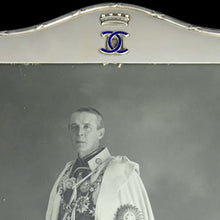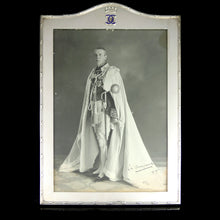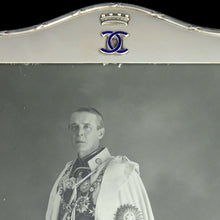British Raj - A Viceregal Presentation Portrait of Lord Chelmsford, 1917
Adding product to your cart
Height: 38cm (15in)
Full length photograph portrait of Chelmsford in Governor-General’s uniform and mantle and insignia of the Most Exalted Order of the Star of India. Signed and dated in ink in the viceroy’s hand ‘Chelmsford / 1917’. Contained in a silver over wood frame of plain design within banded reed border, the arched top applied with an interlinked ‘C’ cypher in navy blue enamel beneath a baron’s coronet. Hallmarked with Hamilton & Co’s elephant mark and stamped ‘Silver’. Maker’s name of ‘Hamilton & Co / Calcutta to the lower edge. Glazed.
Read more
Lord Chelmsford (1868-1933) served as the urbane, brilliant and patrician fourteenth Viceroy of India from 1916 to 1921. Educated at Winchester and Magdalen College, Oxford, he was called to the Bar in 1893 from London's Inner Temple. Chelmsford, a Fellow of All Souls, was a brilliant student of law who served with distinction as Governor of Queensland from 1905 to 1909 and of New South Wales from 1909 to 1913. At the start of the First World War he mobilised with the 4th Dorsets in which he was a captain, and went with them to India. He succeeded Lord Hardinge as Viceroy of India in 1916 in the wake of the British defeat in Mesopotamia, and as Indian discontent was growing. Lord Hardinge, it might be added, had been wounded earlier in Delhi by an assassin’s bomb thrown into his elephant’s howdah.
Chelmsford's viceroyalty is remembered for the Montagu-Chelmsford Reforms, as embodied in the Government of India Act of 1919, that increased the representation of the Imperial Legislative Council in India by transferring several departments of India's central government to elected Indian members rather than appointing British officials to run them. Trying to tread a fine line between reform and maintaining the British hold over India, Chelmsford passed repressive anti-terrorism laws to widespread opposition from Indian reformists, resulting in the introduction of martial law and the culminating in Brigadier Dyer's massacre of unarmed demonstrators trapped inside Amritsar's Jallianwala Bagh in April 1919. The massacre radically altered the nature of Anglo-Indian relations, revolutionizing millions of Congress members and converting thousands of hitherto loyal Anglophile Indian professionals into ardent nationalists demanding swaraj (freedom).
The Royal Warrant holders Hamilton & Co. were India’s premier jewellers and silversmiths under the Raj. The firm was founded by Robert Hamilton (1772-1848) who opened a shop at 5 Tank Square, Calcutta in 1808 under licence of the East India Company. In 1811 the business moved to 7 Court House Street, where it remained until its closure in 1973. The firm supplied official jewellery to the princely states, presentation pieces for the Government of India, and competed for government and state contracts. Branches were established at Bombay from 1868 and Delhi and Simla in 1865.








